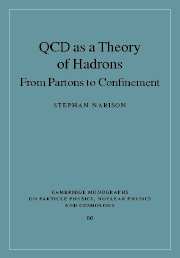Book contents
- Frontmatter
- Contents
- About Stephan Narison
- Outline of the book
- Preface
- Acknowledgements
- Part I General introduction
- Part II QCD gauge theory
- Part III MS-bar scheme for QCD and QED
- Part IV Deep inelastic scatterings at hadron colliders
- Part V Hard processes in e+e– collisions
- Part VI Summary of QCD tests and αs measurements
- Part VII Power corrections in QCD
- Part VIII QCD two-point functions
- 31 References guide to original works
- 32 (Pseudo)scalar correlators
- 33 (Axial-)vector two-point functions
- 34 Tensor-quark correlator
- 35 Baryonic correlators
- 36 Four-quark correlators
- 37 Gluonia correlators
- 38 Hybrid correlators
- 39 Correlators in x-space
- Part IX QCD non-perturbative methods
- Part X QCD spectral sum rules
- Part XI Appendices
- Bibliography
- Index
37 - Gluonia correlators
from Part VIII - QCD two-point functions
- Frontmatter
- Contents
- About Stephan Narison
- Outline of the book
- Preface
- Acknowledgements
- Part I General introduction
- Part II QCD gauge theory
- Part III MS-bar scheme for QCD and QED
- Part IV Deep inelastic scatterings at hadron colliders
- Part V Hard processes in e+e– collisions
- Part VI Summary of QCD tests and αs measurements
- Part VII Power corrections in QCD
- Part VIII QCD two-point functions
- 31 References guide to original works
- 32 (Pseudo)scalar correlators
- 33 (Axial-)vector two-point functions
- 34 Tensor-quark correlator
- 35 Baryonic correlators
- 36 Four-quark correlators
- 37 Gluonia correlators
- 38 Hybrid correlators
- 39 Correlators in x-space
- Part IX QCD non-perturbative methods
- Part X QCD spectral sum rules
- Part XI Appendices
- Bibliography
- Index
Summary
Pseudoscalar gluonia
We shall be concerned with the correlator:
where QR(x) is the renormalized gluon topological density which mixes under renormalization with the divergence of the flavour singlet axial current mix as follows [129] (see Section 10.3.3 in Part III):
where:
and we have quoted the formulae for nf flavours. The correlation function X(k2) obeys the inhomogeneous RGE [260]:
The anomalous dimension is:
The extra RG function β(L) (so called because it appears in the longitudinal part of the Green function of two axial currents) is given by
The RGE is solved in the standard way, giving
where αs(t) is the running coupling. The different QCD diagrams contributing to the correlator are shown in Fig. 37.1.
The perturbative expression for the two-point correlation function in the scheme is [455]:
The non-perturbative contribution from the gluon condensates (coming from the next lowest dimension operators in the OPE) is [382]:
Pseudoscalar meson-gluonium mixing
Let us consider the off-diagonal two-point correlator:
shown in Fig. 37.2.
Its QCD expression reads [458]:
where one can notice that the mixing from the OPE vanishes in the chiral limit. However, one should notice that this mixing acts on the gluonium propagator, that is, it affects the mass splitting but not its decay width which is governed by a three-point function. Unfortunately, several authors mix these two features in the literature.
- Type
- Chapter
- Information
- QCD as a Theory of HadronsFrom Partons to Confinement, pp. 378 - 385Publisher: Cambridge University PressPrint publication year: 2004



